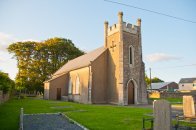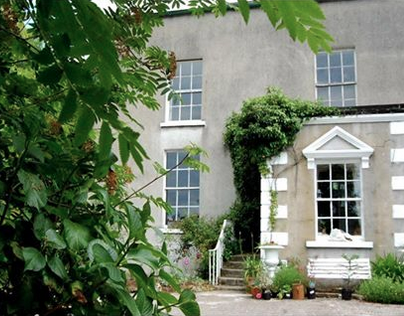Ancestry of Harriet Owen (*1836)
|
Page AS III.2 to overview
|
Robert Owen
*b 19-02-1722 Pontesbury
+ 1810 (Dublin?) |
NN Heron
*
+ |
x |
|
Loftus Cliffe
* 1710
+ 1766 |
Anne Hore
* ~1740
+ |
x |
|
|
|
Roger Carmichael Owen
*
1756
+ 1843 Camolin
(Rector) |
Anne Cliffe
*
+ 1844 Camolin |
x 01-05-1783 |
|
nn
*
+ |
Lindsay of Balcarres
*
+ |
x |
|
Frederick Owen
*
18-11-1800
+ 03-07-1895 Coolkenno (Co Wicklaw)
(Reverend) |
Frances Dalton
*
+ |
x
St.Anne's, Dublin |
|
Harriet Owen
* 11-04-1836
+ 1927 Wisham, Warwickshire, England x William Bedell Stanford |
Robert
Children: William, Roger, Letitia (x Rev. Edwin Kynaston),
Jane (x Rev. Tobias Adams).
In 1798 he resided at Summerseat, three miles from Wexford town.
He made a will, dated 10-12-1806, + proved 1810 in Dublin.
Loftus and Anne
Children:
Barbara (grandmother of William B. Stanford),
Dorothy, Anne.
Roger and Anne
He was Rector of Camolin 1781-1844.
Camolin is a town in Co. Wexford, SE Ireland.
Children: 1784 Robert, 1786 Loftus, 1792 William, 1796 Richard, 1797
George, 1794 Anne, 1802 Harriet (x Franklin Chambers),
1800 Frederick.
|
In 1798 there was a rebellion in Ireland. From
Wikipedia:
|

Church of Camolin
|
It was an uprising against British
rule in Ireland lasting from May to September 1798. The United
Irishmen, a republican revolutionary group influenced by the ideas
of the American and French revolutions, and also advocating the
rights of catholics as well as presbyterians, were the main organising force behind the
rebellion. Roger was maltreated by the rebels.
Roger Owen, Rector of Camolin, escaped by feigning to be deranged
in his understanding. This clergyman has given since the rebellion
full proof of a genuine spirit of christian charity for though
treated with such cruelty by the rebels that he could hardly be
expected to survive his hardships, he has endeavoured since, as
far as in his power, to mitigate the rage of the lower classes of
Protestants, who have been apt to regard all Romanists in the same light.
[From a letter by Jane Adams (née Owen) to her sister Letitia.]
It is believed, that in Co. Wexford some 6000 people died, in battles
or just in killings, between 1798 and 1820.
|
|

Frederick Owen, date unknown (from FOSA)
|
Frederick and Frances
Frederick Owen was rector of Coolkenno
(at the border of County Carlow and County Wicklow), SSW of Dublin
in Ireland.
He lived for over 80 years. Grandson Edwin Stanford (ESM) writes:
when over eighty used to tip a whole scuttle of coal
on to the fire at one shot just to show he could do it.
Children: 1828 Frederick, 1832 Henry, 1834 William, Anne (x T.Hoskins),
1836 Harriet (x William Stanford) [Harriet and William were related, their grandmothers Cliffe were sisters],
1837 Bedell, Frances Maria (x P.Pratt),
Louisa (x rev. Robert L.Stanford, brother of Harriets husband),
Thomassina (x A. Montgomery).
[ See Swanzy, p.31: Harriet, 2nd dau. of the Very Rev. Frederick Owen, M.A.,
Dean of Leighlin, son of the Rev. Roger Carmichael Owen,
Rector of Camolin, Co. Wexford,
by Anne, dau. of Major Loftus Cliffe. ]
|

Coolkenno, the Old Rectory
(from History Coolkenno; facebook)
|
From History of the Coolkenno Area
(on facebook.com):
According to Richard Codd's "The Field of the Apple Trees",
On 26th April 1868, Rev. Frederick Owen wrote a long letter to the Aghold
Parishioners urging for fundraising to be exacted upon refurbishment
of Littlewood School. An agreement was made with the Estate Office
in Coolattin that the Parish would lease the premises for 99 years
at one shilling per annum, for the purpose of a schoolhouse
connected with the Protestant Established Church, or such Church as
shall correspond therewith, on any new Parliamentary arrangements.
He appealed for £ 16 to be gathered for the costs of refurbishment
and this was successful by the year's end.
The old parish of Aghold, descendant of the Aghowle monastery,
contained the townlands of Aghowle, Coolkenno, Killinure, Munny,
Killabeg, Kilquiggan, Gowle, Boley, Munahullen, Raheenakit and
Barnamuinga (western end of Co. Wicklow).
On: Coolkenno Glebe - The Old Rectory, Killabeg
(from facebook.com/Coolkennohistory):
This building, nestled on
the southern slopes of Gowle Hill was once home to the Aghold Parish
Anglican Rectors for close to 250 years.
Why is it called Coolkenno Glebe when it is in Killabeg?
Good question!
One sure thing, one of the finest views of the Glebe is from the site of St. Michael's.
The actual purchase and ownership of the Glebe lands
(glebe,
land serving as part of a clergyman's benefice and providing income)
were detailed on the Vestry Minutes from October 12th 1875.
It appears communication
with the Representative Church Body was successful in regards of
purchasing the house and associative lands for the benefit of the parish.
This was resolved at £ 515, with a vast amount of the price
donated by the Parishioners. At a meeting of the Select Vestry held
on 26th Dec. 1877, it was resolved that the detached holding on the
Glebe, commonly called "Walker's Holding", having been purchased
by the Parish from the Commissioners of Church Temporalities, the
Rev. Frederick Owen be requested to communicate with the
Rep. Ch. Body with a view to having the said holding vested in them
for the benefit of the Parish. On April 23rd 1878, the Parishioners
recorded their deep sense of obligation to their venerated and
respected Pastor, the Rev. Frederick Owen, for his kindness and
generosity in waiving all claims to the purchase of the Glebe lands
lately offered for sale, but also for securing the same in
perpetuity to the Parish of Coolkenno.
Some details about the persons on this page have been taken from
Henry Biddall Swanzy: The families of....
The son of WBS, Frederick Owen Stanford,
did extensive research on the ancestry. This is available in FOSA.
FOSA: Ancestry of J.O.Stanford; in the Jacometti-Stanford archive.
ESM: Edwin Stanford's Memmoirs to about 1915;
in Jacometti-Stanford archive.
(2017.04.05) initiated October 2013.


